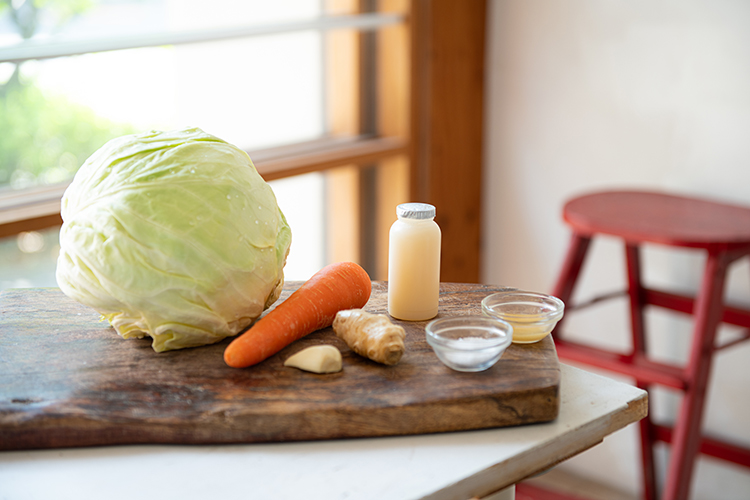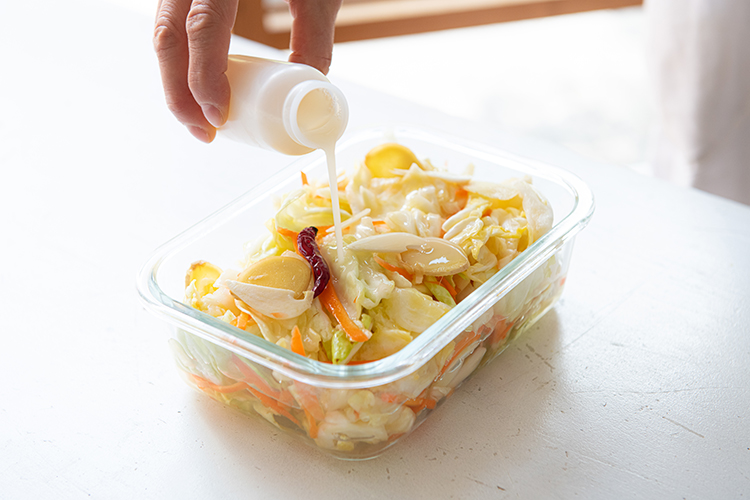Fermented Salads & Fruits by Izawa Yumiko
Jun 08,2023
Fermented Salads & Fruits by Izawa Yumiko
Jun 08,2023


Izawa Yumiko is known for her easy and delicious fermentation recipes that get the most out of their ingredients. For this article, Izawa chose her simple, foolproof fermented salad from the many choice fermented foods she recommends. Rumor has it that once you start making fermented salads, which are packed full of nutrients that your body will love, you won’t be able to stop making them again and again. Izawa also shares a super-quick recipe that uses the fermented salad.

As she brews her favorite Taiwanese tea, Izawa remarks: “Taiwanese tea is also fermented. I love its wonderful fragrance and sweetness.”
Izawa Yumiko has been a driving force behind the popularity of easy-to-make fermentation recipes such as lemon salt and lactic acid cabbage. Her fascination with fermentation dates back to her childhood.
“I spent a lot of time with my grandmother when I was young, and she had a profound influence on me. My grandmother made her own pickles and miso, and she also made preserves out of produce from her garden. Back when I was a preschooler, my daily routine when I got home was to stick my hand in the nukadoko [a bed of salted rice-bran paste for pickling] and pull out the vegetables that were ready to eat and nibble on them. (laughs) I loved doing it because it was like a treasure hunt. To my child’s mind, eating these vegetables appeared to give me energy and make me feel good. Kids are constantly on the move and get hot and sweaty. That’s why I think I was so sensitive to the feeling of being energized by the salty foods that were nice and cool.”
Having grown up in an environment where fermented foods were a part of everyday life, Izawa was naturally inclined to become interested in dietary therapy, and she became intrigued by the actions and workings of microorganisms as well.

“Even a single pickled cucumber will taste different today than it did yesterday or it will tomorrow. Foodies and gastronomes want to know the perfect amounts of everything and all the exact techniques. But with fermented food, the umami flavor, aroma, and even nutrients change day by day due to the intricate actions of microorganisms. I call these actions a ‘flood’ of microorganisms. The flood of microorganisms is beyond human control. There is real joy in exploring the flavors you like in rhythm with the actions of living microorganisms.”

The ingredients for the fermented salad are your preferred vegetables, salt, honey, and a plant-derived lactic acid bacteria drink. These simple elements blend together through the fermentation process to create a complex taste.
Izawa conceived of this fermented salad recipe to make the wonders of fermented food accessible to as many people as possible, with the added bonus of being easy and foolproof for anyone to make.
“All fermented foods are simple to make. For example, to make my fermented cabbage, all you have to do is rub some salt into shredded cabbage and let it ferment at room temperature for three to six days. However, because of the paper-thin line between rotting and fermenting, first-time makers may find it challenging to tell whether the cabbage is fermenting or rotting. That’s why I came up with the fermented salad I’m sharing here. The base is nabak (watery) kimchi, but the distinction is that this recipe uses a lactic acid bacteria drink. Because of the drink, it is easy to see whether you have reached your goal, since the recipe will definitely ferment if left overnight at room temperature.”
While rice water is normally used to make nabak kimchi, Izawa’s recipe uses a plant-derived lactic acid bacteria drink instead of rice water.
“The rice water feeds the lactic acid bacteria and promotes fermentation. A lactic acid bacteria drink, however, is itself already fermenting. This difference is why the recipe will ferment nicely in one day without fail. Any lactic acid bacteria drink will work, but I recommend a plant-derived drink. Such drinks are refreshing and harmonize well with vegetables and fruit.”

The salad can be refrigerated for up to a week, and the further the fermentation progresses, the more refreshing acidity is added and the more intense the umami and richness

Work in the salt and honey thoroughly, and when the overall mixture has become supple and the bulk reduced, transfer to a storage container. If you wish to use the pickling liquid as baby food for children under the age of one, leave out the honey and substitute an equal amount of beet sugar or cane sugar.
“What you are aiming for is about 700 grams in total for the vegetables or fruit. You can use any vegetables that can be eaten raw, such as celery, lettuce, Chinese cabbage, or turnips. Enjoy whatever seasonal vegetables you like.”

The final step is to pour the lactic acid bacteria drink, which will propel the fermentation process, over the salad
“It’s very reassuring to have chilled salad in the fridge that you can eat anytime. On a hot day or when you are feeling tried, try drinking the pickling liquid, which has a sour and umami taste. The pickling liquid contains more than 10 times the lactic acid bacteria of regular kimchi. Fermented vegetables are gentle on the stomach and intestines because their nutrients are easier to absorb, thanks to the action of their enzymes. Good bacteria are activated. As research into the brain-gut connection has progressed, the concept that the gut is the body’s ‘second brain’ has become well recognized. I sense this deep connection between body and mind too, as I continue to make and eat fermented food. I think it’s absolutely true that the body and mind are what we eat.”

Dissolve 1.5 teaspoons of chicken stock in 1 tablespoon of hot water, and dilute to your desired consistency with the pickling liquid to make a soup swimming with lactic acid bacteria. Top with strips of thin omelette or ham and serve.
How about a dish of chilled noodles with fermented salad that goes down smoothly on days when you don’t feel like eating or when you get home late? Just chill boiled udon, pasta, or vermicelli noodles in running water, place some fermented salad on top, and add chicken stock soup diluted to taste with pickling liquid, and you’re done.
“Even if you put chilled pickling liquid on hot noodles, eating it will make your stomach feel relieved. It’s also delicious with yuzu kosho [a condiment paste made from yuzu citrus zest and chili peppers] or a squeeze of lemon. Putting a little vinegar in the soup will add a refreshing zing.”
You can quickly transform fermented salad into coleslaw by mixing in some mayonnaise or into gyoza or shumai dumpling fillings by chopping it up and mixing it with some meat. It is a handy pre-made resource to save time when cooking.
“You can change the salad’s character by adding olive oil, or even make it into a namul-type [Korean herbal] dish by mixing in sesame oil. Introducing a high-quality oil will promote further peristalsis by the intestines. Sprinkling freshly grated pecorino or parmesan on the fermented salad makes the perfect side dish for a glass of chilled white wine. It’s one of the things I enjoy on my days off.”
By substituting fruit for the vegetables in the fermented salad, you can make a snazzy fermented fruit dish. Try using less salt to bring out more of the sweetness of the fruit.

For 700 grams of fruit (pictured are apples, radishes, kiwi fruit, and oranges), combine 2 teaspoons of salt, 1 teaspoon of honey, 2 bottles of lactic acid bacteria drink, and 200 mL of water
Cut firm fruit like apples into bite-sized pieces leaving the skin on and place them in a clean container. Drizzle salt and honey over them and gently mix them together. Softer fruits like kiwi fruit can be added directly to the container. After adding the water and lactic acid bacteria drink, leave the mixture in the refrigerator overnight and consume it within a week.

Add fermented fruit on top of plain yogurt and mix in the pickling liquid for a cool snack. This dish can be a delightful palate-cleansing dessert or a great snack when you are a little peckish.
“Vitamins are known to be good for skin beauty. And yogurt, which is a dairy product, is a source of serotonin — the ‘happiness hormone’, and it helps to regulate and balance the autonomic nervous system. The combined power of the ingredients gives you a synergistic boost of both taste and nutrition. The creamy yogurt goes well with the fermented fruit, which retains a soupcon of saltiness amid its pleasant sweetness. You can add honey or maple syrup for an even richer taste.”
For our next installment, Izawa Yumiko will pass the baton to Kawahara Ai, who is currently a freelance writer and has a doctorate in bacteriology from an environmental-studies graduate school. Be sure to watch out for it!

Cooking expert
Cooking expert
A cooking expert, a chef, and an internationally qualified Chinese medicine practitioner, Izawa is active in many fields including TV and magazine appearances, restaurant design, and product development. She has extensive knowledge of fermentation and medicinal cooking, and her simple, tasteful recipes that use ingredients to their full potential are very popular. She is the author of many books, including Pickles That Bring Your Body Joy (Seibundo-shinkosha) and Fancy Meals and Daily Side Dishes Made with Staub Cookware (Shufu-no-tomo Publishing).